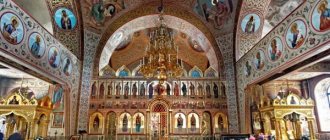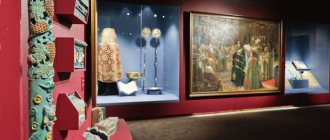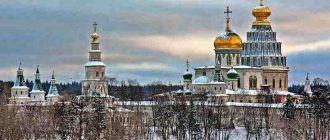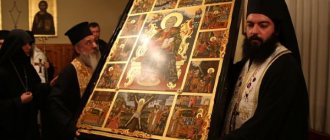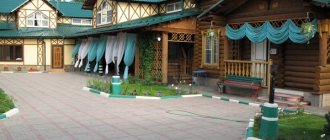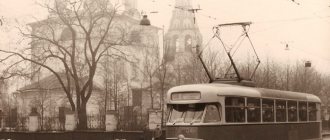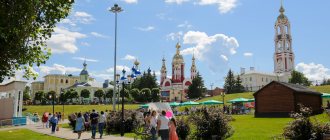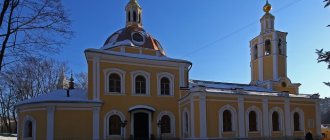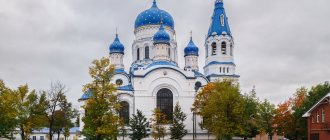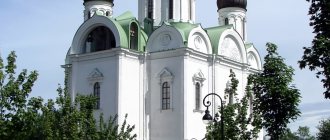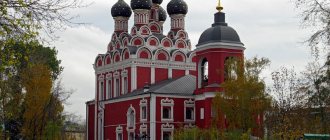The Chernigov skete (Cave branch of the Gethsemane monastery) in Sergiev Posad is a metochion of the Trinity-Sergius Lavra. Today the skete is a functioning monastery, where only 10 monks serve.
The church complex with a large stone Temple in the name of the Mother of God of Chernigov-Gethsemane once began with a small cave dug by Philippushka the Blessed. Restored according to descriptions of eyewitnesses and drawings, the underground altar, which served as a sewage pit in Soviet times, has regained its original appearance and attracts pilgrims and tourists from all over the world.
Historical events
The Chernigov monastery in Sergiev Posad was founded 3 km southeast of the Trinity-Sergius Lavra, on the northern shore of the Korbushinsky pond, by the hermit monk Filippushka Yurodiv in 1847. Opposite him, across the pond, was the Gethsemane monastery (founded in 1844 .), to which at the end of the 19th century. The Chernigov monastery was attributed.
Back in 1845, several monks of the Gethsemane monastery, inclined towards complete solitude and renunciation of everything worldly, began to build wooden cells in the Isakovskaya Grove, on the opposite bank of the pond.
The Holy Fool Philippushka (blessed Schemamonk Philip), who lived at the Lavra, having asked for a blessing to dig a “cellar”, in 1847 dug himself an underground cell. It was this year that began to be considered the date of the creation of the Chernigov monastery. Other monks began to dig “cellars” nearby. The first cave temple was a log half-dugout, consecrated in the name of the Ethereal Heavenly Forces.
The upper part of the temple had small windows, the lower, underground part was connected to neighboring caves by long, winding underground passages. The monks did all the excavation work by hand, in the most difficult conditions, with enormous humidity, suffocating from the heat in the summer and freezing in the winter. They say that 2 monks died in the collapses.
On September 27, 1851, the cave temple was renamed and consecrated in honor of Archangel Michael and other ethereal forces by Metropolitan Philaret. The icon of the Chernigov Mother of God was donated to the temple in 1852 by noblewoman Alexandra Grigorievna Filippova, in whose family the icon was kept for more than half a century.
The long and difficult history of the Skete is marked by important milestones:
- 1857 _ – the above-cave wooden church of St. Anthony and Theodosius of Pechersk was erected.
- 1921 _ - the monks were transferred to the Gethsemane monastery. The Chernigov monastery was turned into a prison, then a home for the disabled and warehouses were located here.
- 1990 – revival of the skete as a monastery assigned to the Lavra.
- Since 2007 Most of the monastery is occupied by a boarding school for disabled children. Number of monks from 2006 to 2009 reduced from 25 to 10 people.
Temples located in caves
Most pilgrims who have visited the local catacombs note the mystical beauty and intriguing aura. Groups for excursions to the caves are formed in the monastery church. The underground complex is made up of several churches. The oldest building is dedicated to the Archangel Michael, the head (archistratig) of the holy army of heavenly protectors.
Modern view of the caves of the Chernigov men's monastery
- Behind the main altar of this church there is a chapel in honor of the “Iveron” Mother of God; it was erected at the end of the 19th century. The building preserves incredibly beautiful frescoes. On a guided tour, tourists can see and offer prayers to the tomb of Philip of Gethsemane, the founder of the “caves.” The relics of the abbot of this monastery, Elder Barnabas, are kept nearby.
- In the far area of the cave catacombs there is a church consecrated in honor of the Pechersky couple. The underground church took its name from the divine upper structure, which towered over the complex for three decades.
- Tourists and pilgrims here observe the monastic way of life and small cells. One can feel the unprecedented spirit of an ascetic lifestyle, content with the smallest and most necessary.
Read about church life:
- What prayers are read before confession and communion?
- How to properly place candles in a temple
- Rules for storing Orthodox icons
Interesting! When the Bolsheviks seized power, the state gave instructions to completely flood the underground church town. Recovery occurred only in the early 2000s. The consecration took place in 2006. Talented graduates of the art school worked on the restoration of the temple painting.
Architecture, appearance
The Chernigov monastery in Sergiev Posad today is an architectural ensemble centered around the 5-domed stone Chernigov Temple. A large church was erected in the name of the Mother of God of Chernigov-Gethsemane in the period from 1886 to 1889. The cave church, which gave rise to the monastery, is located directly below the Temple.
In 1857, an underground refectory with a vaulted ceiling was added to the cave church from the west. From that moment on, the church began to be called an altar.
The design and construction of the stone above-cave Temple was carried out under the leadership of N.V. Sultanova. The ingenious architect was able to design a powerful foundation in damp, unstable soil, and build the walls of the temple without damaging the altar underneath. The cave church was active throughout the entire period of construction.
In addition to the Temple, the monastery complex includes:
- a chapel in the name of St. Vladimir of Serbia, built over the holy spring;
- 5-tier bell tower 71 m high, above the main entrance to the monastery;
- Church in the name of St. Nicholas the Wonderworker (north-west of the chapel);
- temple in the name of the pious Constantine and Helen (behind the chapel, to the right of it);
- 2-storey Southern cell building;
- 1-storey cell building along the eastern fence;
- 2-story refectory along the western fence;
- The Bogolyubskaya monastery, as a burial place for the schema-monk brothers, was founded by Blessed Filippushka in 1858, to the west of the monastery, on the shore of a nearby pond. Later, a 2-story stone church was erected above it.
The entire ensemble of the monastery is designed in a pseudo-Russian style, preserving the classical traditions of Old Russian architecture.
Current state[edit]
The return of the monastery to the Church began on September 13, 1989. On the eve of the holiday in honor of the Icon of the Mother of God “Chernigov Gethsemane”, the first meeting of the abbot of the Holy Trinity Sergius Lavra, Archimandrite Theognost (now Archbishop of Sergiev Posad) took place with representatives of the Zagorsk City Executive Committee, and on April 11, 1990, secular authorities decided to gradually transfer the Chernigov monastery to the Lavra.
On July 18, 1990, the monastery was visited by His Holiness Patriarch of Moscow and All Rus' Alexy II. Since then, the revival of this holy place began, both externally and internally, spiritually. The Liturgy is again served in the church, prayers are offered, and much work is being done to restore the former beauty of the monastery.
In his speech at the end of the Divine Liturgy celebrated in the monastery on March 10, 2012, His Holiness Patriarch of Moscow and All Rus' Kirill Fr.
To date, a large amount of architectural and restoration work has been carried out in the cathedral in honor of the Icon of the Mother of God “Chernigovskaya Gethsemane”, the cave churches of the Archangel Michael and the Venerable Anthony and Theodosius of Pechersk have been restored, the bell tower and the churches of St. Nicholas, the Myra of Lycian Wonderworker, and the Saints located in it have been renovated Equal-to-the-Apostles Constantine and Helena, on the shore of the pond a wooden over-chapel has been recreated, in which, even before the revolution, numerous pilgrims collected water from the source.
The monastery complex includes the following buildings:
- Cathedral in honor of the Icon of the Mother of God “Chernigov Gethsemane”
- Temple of the Archangel Michael
- Temple of St. Nicholas, the Wonderworker of Myra of Lycia
- Chapel in honor of the Holy Prince Vladislav of Serbia
- Bogolyubskaya Kinovia with churches in honor of the Bogolyubskaya Icon of the Mother of God and the Holy Blessed Prince Igor of Chernigov
Bogolyubskaya Kinovia
On the shore of the Skete ponds, far from noisy roads, in the depths of the forests, not far from the Gethsemane Chernigov Skete of the Holy Trinity Sergius Lavra in a place called Korbukha, a century and a half ago (in 1858) the blessed schemamonk Philip founded Bogolyubskaya Kinovia (from the Greek “cinnovia” " - "dormitory").
At the very beginning, a two-story church with two altars was built here: in the name of the holy women Matrona and Capitolina on the lower floor and in honor of the Bogolyubskaya Icon of the Mother of God on the upper floor. In this quiet, peaceful place, near a two-story church, a cemetery for the brethren of the Holy Trinity St. Sergius Lavra was established. Schemamonk Philip was buried in the lower church. Several years ago, his honest remains were transferred to the Iveron Chapel of the Skete caves.
Gradually, Kinovia expanded and turned into a large communal monastery. Five wooden cell buildings were built for the brethren, one of which had three floors; behind the fence stood a wooden building of a hospice; maintained its own barnyard. In 1875, a stone two-story refectory building was built on the western edge of the monastery. Between the church and the refectory, the Holy Gates were erected - the main entrance to the territory of Kinovia for pilgrims. To approach the gate, pilgrims had to cross the bay of the monastery pond on a wooden bridge and then climb the steps of a rather steep staircase built along the slope of the hill on which the gate stood. In 1907, Kinovia was surrounded by a stone fence 250 fathoms long.
Unfortunately, even in these remote places in the 20s of the last century the terrible yoke of persecution against the Church came, which destroyed not only most of the buildings in Kinovia, but also the necropolis, the tombstones from which were blasphemously used to pave the road. Kinovia was closed after the revolution on May 2, 1922. All valuables (icons, utensils) were confiscated from the monastery and transferred to the famine relief fund. Then the territory of the monastery became a garment factory.
Only a stone single-domed church in the Old Russian style with a hipped bell tower has survived to this day, which has recently been returned to the jurisdiction of the Russian Orthodox Church.
Repair and restoration work to restore the Church of Bogolyubskaya Kinovia began in 2012. Now, thanks to the efforts of benefactors, the temple has been restored to its former splendor.
The great consecration of the temple in honor of the Bogolyubsk Icon of the Mother of God took place on July 24, 2022.
The great consecration of the temple in honor of the holy noble prince Igor of Chernigov took place in Bogolyubskaya Kinovia on August 30, 2019. The rite was performed by the vicar of the Holy Trinity Sergius Lavra, Bishop of Sergiev Posad Paramon.
Chapel of the Holy Blessed Prince Vladislav of Serbia
Gethsemane Chernigov Skete was founded in 1844. Through the efforts of Schemamonk Philip, a cave section was formed in 1847. Soon after the excavation of the caves, a spring appeared there, at a depth of about 15-20 meters. The brethren used the water from it as well water. After the construction of the cathedral in honor of the Icon of the Mother of God of Chernigov, the Gethsemane treasure was located on the western side of the temple, directly under the porch.
For the convenience of collecting water, a chapel was built, into which numerous pilgrims came to the monastery to pray before the miraculous image of the Mother of God of Chernigov of Gethsemane. After the glorification of the miraculous icon, people began to receive grace-filled help in healing various ailments from the source.
In the twenties of the 20th century, the water drainage system from the underground well was destroyed and all the buildings fell into complete disrepair, and the chapel itself was completely destroyed. According to the Providence of God, through the labors of specialists and the care of pious Orthodox Christians, the water drainage has now been restored, a font has been equipped and a chapel has been built over it in honor of the holy noble prince Vladislav of Serbia. The rite of consecration was performed on September 14, 2016, the day of the glorification of the Icon of the Chernigov Mother of God of Gethsemane. Once again, as in historical times, access to a supply of water is open for consumption for the benefit of soul and body.
The chapel is open from 5:00 to 21:00.
Interior decoration
The interior decoration of the Church of the Mother of God of Chernigov-Gethsemane amazes with its grandeur and beauty. Superbly executed frescoes, icons in expensive frames, a painted vaulted ceiling with images of the most revered saints, a shrine with the relics of St. Barnabas - at the sight of all this, your heart skips a beat, you want to speak in a whisper and turn to the Lord only with the most pressing problems.
At the entrance to the Temple, headscarves and skirts are offered; it is considered a sin for women to enter with their heads uncovered and in trousers. The underground cave temple is quite ascetic inside. There are also many icons here, the faces of saints look out from all the walls.
But everything was done in a simple and austere style, recalling that monks lived here in the harshest conditions, the strictest fasting and constant deprivation, whose whole life consisted of incessant prayers and self-torture. The vaulted walls in the corridors and cells are painted with ancient Russian ornaments, the floor is lined with thick tiles.
Chernigov Skete of Gethsemane in Sergiev Posad inside.
The perimeter of the monastery is surrounded by a red-brick wall of thick 0.5-meter masonry, with towers in the corners. The area is well-groomed, clean, divided into lawns, surrounded by fragrant flower beds. There are signs, warnings and explanatory signs everywhere.
In front of the gates of the monastery, the waters of the Gethsemane ponds, which once separated the Chernigov monastery from the Gethsemane monastery, glisten under the sun. Swans and ducks swim here, which visitors love to feed.
On the territory of the monastery there are two refectory-cafes, where monastic food, delicious pastries, aromatic and invigorating, yeast-free kvass, brewed using the monastery’s own technology, are offered. There is pine, spicy ginger, beet kvass.
In the church shop you can buy icons, blessed crosses and silver rings with the inscription “Save and Preserve.” They also sell gold wedding rings with words of protective prayer applied to the inner surface. The church shop accepts orders for tours of the caves. There is a stall with souvenirs.
Activities of the monastery[edit]
- Sunday School
- Confectionary shop
At the Gethsemane Chernigov monastery there is a small confectionery shop that provides delicious baked goods not only to the brethren, but also to parishioners. We offer Easter cakes and Easter cakes made by our confectionery shop (chocolate Easter, with boiled condensed milk, with candied fruits, with raisins, with nuts, with prunes, with almonds). The shop's assortment includes not only ordinary pies with a wide variety of fillings, but also wonderful cakes that can decorate any holiday table. During Lent, vegetable fats are used to make cakes, dough and cream. A wide variety of breads and kvass are made according to ancient recipes. All bread is made without the use of yeast.
Shrines
The Chernigov monastery in Sergiev Posad has amazing powerful energy. The place, prayed for by several generations of monks, has an aura of holiness; a feeling of peace and tranquility arises here. All problems suddenly lose their severity, and confidence in help from above arises.
There is no fuss and ostentatious piety here; the spirit of business from faith, which, unfortunately, many famous Temples are guilty of, has not yet penetrated here.
The following shrines are kept in the Chernigov monastery:
- The cathedral houses the main shrine of the monastery - the relics of St. Venerable Barnabas, numbered among the host of Radonezh saints. From the Hebrew "Barnabas" is translated as "son of consolation." He lived in the Chernigov monastery for 47 years, 33 of them in the guise of a holy elder. Pilgrims from all over Russia came to him, seeking consolation and strengthening of faith. He could receive and confess up to 500 people a day. In particular, Emperor Nicholas II himself came to him in 1905 along with his entire family. The abbot of the Trinity-Sergius Lavra called Barnabas “the people’s confessor.”
- The relics of Blessed Philippushka are buried in the lower church of the Bogolyubskaya Kinovia. Once upon a time, Philip Khorev, a peasant originally from the Vladimir province, had a family and children. But an insight that once visited him forced him to leave his established life, his family and go wandering around Rus'. Before settling in the monastery, he acted like a fool for many years. In winter and summer he walked barefoot, went hungry, wore beggarly cast-offs, and tormented himself by wearing chains. Filippushka lived on alms, was distinguished by an unusually meek disposition and the gift of prediction, he was called “visionary.”
- On the territory of the Skete there is the burial place of Alexandra Grigorievna Filippova, who once donated the icon of the Chernigov Mother of God to the monastery. She lived her last years in a nursing home at the monastery, prayed a lot, and religiously observed all church canons.
- People constantly approach the two main miraculous icons of the Temple and stand for a long time, fervently crossing themselves and whispering their prayers, many on their knees. The kandilo (candlesticks) in front of them are always full of burning candles: a list from the miraculous icon of the Chernigov Mother of God (September 14 - Patronal Feast). The icon first performed a miracle in 1869, healing a paralyzed woman in the Cave Church of the Chernigov Monastery. The ancient icon repeatedly showed miracles of healing, over 100 of them were recorded; the list from the Icon “The Unbreakable Wall” protects from the evil eye, damage, curses, from loss of property, and saves during a natural disaster, epidemic, or enemy invasion.
- The most important shrine of the monastery, revered and carefully protected, is one of 2 sacred stones, with Orthodox crosses carved on them, brought as a gift to the monastery from Jerusalem by the Russian historian and writer A.N. Muravyov. The surviving stone was taken by Muravyov in the Gethsemane cave, from the tomb of the Virgin Mary. The stone is inserted into the icon case, under it there is an explanatory inscription: “for the blessing of New Gethsemane.”
- The relics of the saints of the Kiev Pechersk Lavra are kept in a special reliquary in the cave temple. Pilgrims overcome by illnesses and misfortunes come to venerate them.
- At the entrance to the temple there is an icon of the Mother of God “Praying”. They pray before her to gain and strengthen faith.
- To the north of the main Cathedral on the territory of the monastery there are burial places of monks, trustees and benefactors. Here lie the remains of famous Russian publicists and philosophers:
- Konstantin Nikolaevich Leontyev (doctor, diplomat, writer and philosopher, who became a monk under the name Clement);
- Vasily Vasilyevich Rozanov, Russian religious philosopher, thinker and writer.
Shrines[edit]
- The miraculous Chernigov-Gethsemane image of the Mother of God.
On September 1, 1869, on the day of the church new year, the Chernigov Icon of the Mother of God, given as a contribution to the Cave Church, shone in the Skete. A paralyzed peasant woman who had suffered from her illness for nine years was healed. From that moment on, over 100 miracles and healings emanating from this icon were recorded. Many sick people rushed to the Skete and venerated the miraculous image. They asked to send oil from the lamp by mail, they ordered prayers in absentia, they even prayed before the image of the icon in books - and everyone was heard, everyone received help. Copies of the miraculous image of the Mother of God have spread everywhere and are venerated in many Orthodox churches. It is no coincidence that the prototype of this icon was found by St. Anthony of Pechersk, the founder of Russian monasticism and the first Russian cave dweller. - Golgotha with a particle of the Tree of the Life-Giving Cross of the Lord
- Stone from the tomb of the Mother of God, brought from Jerusalem in 1850 for the blessing of the new Northern Gethsemane
- Icon of the Mother of God “The Unbreakable Wall”
- Icon of the Mother of God All-Tsaritsa - blessing of Holy Mount Athos, gift of the Vatopedi monastery
- Reliquary with pieces of the relics of the Kiev-Pechersk and other saints
- Holy relics of St. Barnabas of Gethsemane
- Miraculous spring
- Icons with particles of relics: Icon of the Holy Blessed Matrona of Moscow
- Icon of the holy noble princes of Murom Peter and Fevronia
- Icon of St. Nicholas
- Icon of St. Sergius of Radonezh
- Icon of the Venerable Prince Oleg of Bryansk
- Icon of the Holy Blessed Prince Andrei Bogolyubsky
- Icon of St. Maximus the Greek
Interesting facts and legends
Interesting facts that have become legends in the history of the monastery over many years:
- Nicholas II personally came to Barnabas of Gethsemane (canonized in 1995). They talked for a long time in private. They say that Barnabas then predicted a painful death for him and his entire family and the death of the Romanov royal dynasty.
- They say that the Chernigov monastery and the Gethsemane monastery were once connected by an underground passage dug by monks and giving them the opportunity to freely go to the Chernigov monastery to worship in the cave temple.
- Parishioners, who came to the monastery not for the first time, claim that the number of angels surrounding the Mother of God in the “Unbreakable Wall” icon is gradually increasing, the holy faces seem to appear on the icon. No one can reliably confirm this miracle, but everyone looks carefully at the icon and tries to count the angels.
- The paths to the Skete are lined with tombstones from the old skete necropolis, destroyed under the Bolsheviks.
Patronal holidays[edit]
- Icon of the Blessed Virgin Mary “Chernigov-Gethsemane”
- September 14 - Barnabas of Gethsemane (Merkulov), reverend
- July 19, September 13 - Trinity Day
- 50th day after Easter - Michael, Archangel
- September 19 (memory of the miracle in Khoneh), November 21 (cathedral) - Nicholas the Wonderworker, Archbishop of Myra, Saint
- May 22, December 19 - Vladislav of Serbia, noble prince
- October 7 - Icon of the Most Holy Theotokos “Bogolyubskaya”
- July 1 - Igor Chernigovsky, noble prince
- June 18, October 2
Opening hours and schedule of services
The Chernigov monastery in Sergiev Posad is visited by dozens and hundreds of believers every day.
The cathedral holds daily services:
- 5.30 (at dawn) - a general prayer service in front of the shrine with the relics of St. Barnabas;
- 6.30 morning - divine liturgy (Eucharist);
- 11.00 - Akathist at the icon of Our Lady of Chernigov;
- 12.00 — unction (anointing with oil);
- 16.45 - evening liturgy.
Unction in the Skete is performed daily, with the exception of major holidays and Sundays. The sacrament begins at 12.00, it lasts about 2 hours. It is recommended to arrive at the unction service 0.5 hours before the start to sign up and buy a cathedral candle.
In addition to unction, other services and sacraments are served in the Skete:
- magpies;
- wedding;
- baptism;
- funeral service (of the dead);
- commemorations (for health and for repose) - for six months and for a year;
- prayer services.
Every day, from early morning until late evening, replacing each other, the monks read the psalter in front of the lectern. Many pilgrims want to confess and take communion at the Chernigov monastery. This can be done during the daily morning and evening services. In the Bogolyubskaya Kinovia, on weekdays and Saturdays the Divine Liturgy is served at 7.00, on Sunday the service begins at 9.00.
Official portal on the Internet
The official website of the Chernigov Monastery provides complete information about the history of the monastery, its
shrines and ascetics. Every visitor to the monastery can ask a question using a special form.
A separate section contains sermons and instructions from the elders who lived in the monastery. There is a Sunday school at the Chernigov monastery, which is attended by the children of local residents.
The monks of the monastery have their own confectionery production
. There are a variety of pastries, cakes and pastries on sale.
In addition, here you can buy monastery honey, flaxseed oil, sauerkraut and other locally made products. All proceeds from the sale go to restore and pay for restoration work in the monastery.
The photo and video gallery presents images of the past and present appearance of the monastery. Thanks to the official portal, believers who are not able to visit the monastery on their own can get to know it better and make a donation.
On the official website of the Chernigov Monastery you can always find the current schedule of services held in the Chernigov monastery. Liturgy is usually celebrated daily - at 6.30 on weekdays and at 8.30 on Sundays. On the same day at 7.30 a prayer service with Akathist to St. Barnabas is served. The evening service begins around 17.00.
Dungeon tours
The monastery staff, the monks, are very friendly, humbly meek and somehow especially calm and attentive. The excursions are conducted by seminarians from the Trinity-Sergius Lavra. They tell the history of the Skete in detail, with love and respect, show all the relics, and will readily answer any question regarding the most private details.
Those who have been to the Skete more than once say that each seminarian tells his own story, adding his own details to his excursion.
A tour of the Skeet caves attracts everyone; most tourists come here precisely for this. In total, 14 small cells and two large halls were dug underground, at a depth of 6.5 m. The smallest cell is only 2 m long and 1 m wide. Now the caves have been completely restored.
Cost of a group tour of the caves for Russians:
| group size (persons) | adults, up to 10 | adults, over 10 | schoolchildren, up to 10 | schoolchildren, over 10 |
| Cost, rub.) | 800 (per group) | 80 (per person) | 800 (per group) | 40 (with 1 person) |
Cost of a group tour for foreign citizens:
| group size (persons) | adults, up to 10 | adults, over 10 | schoolchildren, up to 10 | schoolchildren, over 10 |
| Cost, rub.) | 1000 (per group) | 100 (with 1 person) | 1000 (per group) | 50 (with 1 person) |
If there are wheelchair users in the group, please inform us in advance, the brother monks will help with the movement of the disabled person around the territory of the Skete. After the excursion, you can independently walk around the monastery, go to the Temple, pray at the miraculous icons, submit notes for health and peace, and light candles.
A holy underground spring, gushing from a depth of 20 m, fills a small underground lake (Gethsemane well). Next to him is a font of holy water. It is believed that by bathing in it, you can remove all your sins and be healed of illnesses.
However, the water is so cold (+4 degrees) that few dare to plunge into it. The font is divided into male and female halves. The chapel in the name of St. Vladimir of Serbia, next to the font, is open daily from 5.00 to 21.00.
Pilgrim[edit]
Schedule of services[edit]
The current schedule of services is presented on the official website of the monastery
Refectory[edit]
For pilgrimage groups, meals are provided at the “Pilgrim’s Meal”, which is located at the entrance gate. The new refectory has a barrier-free environment for groups of citizens with limited mobility, as well as everything for a comfortable stay for parents with small children: there are tables for feeding children, a changing table. In the new refectory, which can accommodate up to 60 people, you can not only purchase baked goods or prepared products, but also order breakfasts, a set lunch or a funeral meal. Meals can be ordered in advance by telephone.
On the territory of the Gethsemane Chernigov Skete, the “Monastery Meal” is open daily from 8:00 to 20:00. From Thursday to Sunday from 10:00 to 18:00 the “Monastery Meal” is open at the bell tower.
In the refectory you can also order and purchase monastery products.
Details on the website
How to get there by car, public transport
The Chernigov monastery, a monastery founded by hermit monks in 1844 in ancient Sergiev Posad, is located quite far from the city center. The trip takes 15 minutes by bus No. 38, get off at the Kalyaevskaya sign. Take minibus No. 7, 18 to the village “Ferma”.
You can get to the village “Loza” (minibuses No. 30,36,37), exit in front of Ferma, at the checkpoint. Then you should cross to the other side of the road, turn north and walk along Solnechnaya Street.
The road will lead to the monastery. Driving route from Lavra:
- turn from Red Army Avenue onto Karl Marx Street;
- at the 2nd intersection behind the railway section, turn left onto Vifanskaya Street;
- turn onto Novogorodnaya;
- after the sign “NIIRP” turn right;
- then drive in a straight line, without turning, to Skeet.
A taxi from the city center will cost approximately 200 rubles. Near the Chernigov Skete there are 2 free, quite large parking lots. From Lavra to Skete it is only 3 km; at a leisurely pace it will take about 40 minutes.
Bus No. 388 runs from Moscow (from the VDNH metro station) to the final stop of Sergiev Posad. The electric train to Sergiev Posad departs from the Yaroslavsky station. It takes longer, from the railway station in Sergiev Posad to the monastery by minibuses No. 7, 8.
History of the Chernigov monastery
Gethsemane was the name of the place where Jesus Christ prayed for human salvation. The Mother of God also found her peace in Gethsemane. A monastery with this name was created in 1843-1844, 3 km from the Trinity Monastery
, in the quiet Isaac Grove. They did this thanks to the efforts of the governor of the Lavra, St. Anthony. At first, several monks began to live here, who had a great tendency towards silence and an ascetic lifestyle. Unlike the monks of the Trinity Monastery, they did not have a salary, and received clothes from “junk” clothes. Even the church utensils used in the new monastery during divine services were at first simply wooden.
Gethsemane Chernigov monastery from a bird's eye view
In 1848, the holy fool Philippushka (1802-1968) settled here among the monks. Not far from the monastery, he began to dig a cell for himself in the ground, like the monks of the Kiev Pechersk Lavra
. And part of the monastic brethren joined the zealous holy fool. Until the fall of 1851, an entire underground complex was dug, which included a temple framed by a wooden frame and small cave cells for monks. At first, all underground structures were made of earth, and were lined with bricks much later.
A year later, the icon of the Chernigov Mother of God was donated to the underground temple. Then, in 1852, the monastery was first visited by Vasily Ilyich Merkulov. At first he led pilgrims to the monastery caves, and then accepted obedience. After 14 years, Merkulov became a monk, and they began to call him Varnava. After a while, he became the people's confessor of the Caves of Gethsemane. The fame of Hieromonk Barnabas among Christians was constantly growing. And many hurried to the “Caves” to receive the elder’s blessing. Thus, in 1905, Russian Emperor Nicholas II confessed to the hieromonk. The following year, Barnabas completed his earthly journey. The Orthodox Church canonized him in the mid-90s of the last century.
General view of the Gethsemane Chernigov monastery
The years 60-90 of the 19th century became the time of active construction of the Gethsemane monastery.
Extensive work was carried out to expand the underground church, a wooden above-ground church was erected, and later a brick Chernigov temple, cell buildings, a fence and a five-tier bell tower were erected.
In 1919, with the advent of Soviet power, the Trinity-Sergius Monastery was closed. And some of the monks began to live in the Gethsemane monastery and the Chernigov monastery. But three years later, the authorities liquidated the Chernigov monastery. The icon of the Chernigov Mother of God was transferred and placed in the Moscow Church of St. Sergius, located in the Rogozhskaya Yamskaya Sloboda.
In 1924, the Gethsemane monastery continued to exist as an agricultural artel. The final dispersal of the monastic brethren occurred in 1928, with the closure of the last church on the monastery territory. The premises of the Gethsemane monastery began to be used for a club for the deaf and dumb. And in the middle of the last century they were given to the military, who blew up all the buildings, and on the vacated site they erected a building for administrative and educational purposes.
The premises of the monastery continued to be used for storage purposes, to house a prison and a special boarding school for war invalids. And finally, in 1990, the long-suffering monastery was returned to the Trinity-Sergius Lavra.
